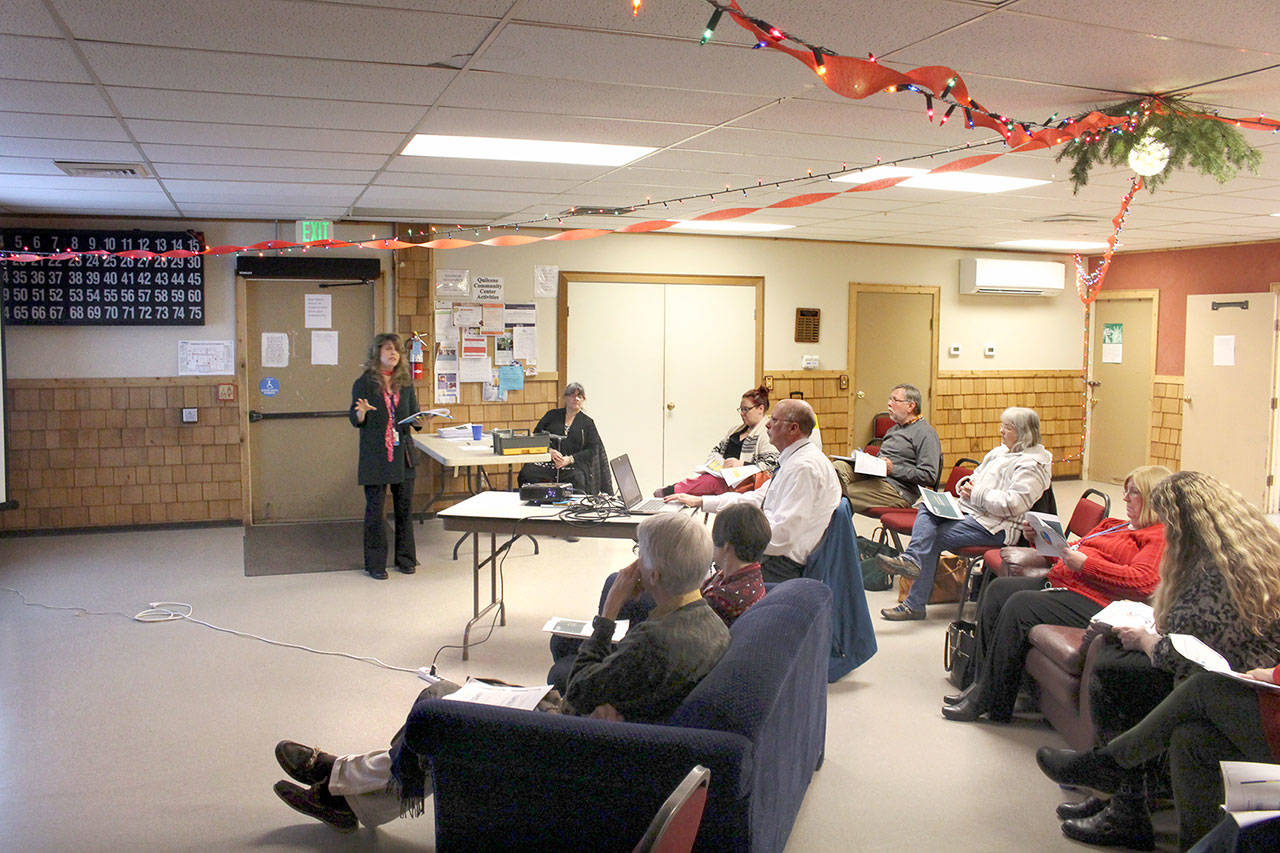QUILCENE — About a dozen members of the Quilcene community gathered to hear a summary of the findings of the Community Health Assessment, which will be used to update the plan for improving health in the county.
Lori Flemming and John Nowak, co-executive directors of the Community Health Improvement Plan (CHIP), presented the information Wednesday night at the Quilcene Community Center.
The meeting was the third of the community conversations, conducted so that the CHIP team could hear what the community thought about the information that was collected during the Community Health Assessment (CHA) that was conducted from April to September. The first two meetings were in Port Townsend and Port Hadlock.
The CHA was also presented at the Joint Board of Jefferson Public Health and Jefferson Healthcare boards at the end of September.
The information in the report was gained through community online and paper surveys, community forums and key informant interviews, recording responses from 1,107 people, Flemming said.
“That’s really good for a community of 30,000,” Flemming said.
The CHA will be used to to create the new CHIP, which is expected to be presented to the joint board in late 2020 for possible approval.
“We have a plan,” Flemming said. “We’re in the process of updating it.”
Through the informant interviews and community forums, the five most key findings to improving overall health were access to health care, aging in place services, affordable housing, childcare/families with young children support and behavioral health coordination and linkages.
Through the community survey, the top five things to improve health and well-being for the county as a whole was more affordable housing, more/better jobs, better access to mental health care, less substance use/abuse and less poverty.
Different parts of the county varied slightly on their order of needed improvements, but the majority of the concerns were the same. However for the Quilcene/Brinnon area (marked as Jefferson South on the CHA), access to mental health care was replaced by access to dental care.
The presentation was a small summary of the information gathered, as the full CHA is a 167 page document that can be viewed at www.behealthyjefferson.com.
Among the data was the information that was collected from the Healthy Youth Survey in 2018 that Nowak described as “disturbing.”
The voluntary anonymous survey collects data about the perceptions, behaviors, and influences of youth on key topics affecting them, the CHA said.
According to the CHA, this data has some limitations: results may not represent youth, as not all students choose to participate and the survey relies on respondent’s own report. Therefore some data may be under or overestimated.
Among the studies, the one deemed moderately positive was the average age that teenagers began drinking alcohol in all of Jefferson County, which is 16-years-old, a slight increase from the 2012 study of 15-years-old, and is equal to the overall state average.
For youth marijuana use, the data was unreliable for sixth grade students, but for eighth-, 10th- and 12th-grade students, the percentages of students who used marijuana in 2018 during the month the survey was conducted was higher than the state averages.
Youth who reported depressive feelings was 42 percent for eighth-grade students, 51 percent for 10th-grade students, and 49 percent for 12th-grade students. All of these percentages were an increase from the 2012 data and are higher than the state averages of 32 percent, 40 percent and 41 percent respectively.
This trend (although not the actual percentages) continued through the data for youth who considered/considering suicide during 2018 and the youth who made a suicide plan. However, for the suicide plan, the statistical difference was negligible between the state average and Jefferson County for eighth and 12th grade students, with 10th grade students being twice as high percentage wise.
The percentage of youth who use alcohol or drugs and also have depressive or suicidal thoughts was again higher than the state averages.
“The Healthy Youth Survey is conducted every two years among youth in grades six, eight, 10 and 12,” the CHA said.
“It is a collaborative effort of the Office of the Superintendent of Public Instruction, the state Department of Health, the state Department of Social and Health Service’s Division of Behavioral Health and Recovery, Educational Service Districts and local health departments.”
The next step for the CHIP team members is to evaluate the data they have received to develop the new CHIP over the coming months.
______
Jefferson County reporter Zach Jablonski can be reached at 360-385-2335, ext. 5, or at zjablonski@peninsuladailynews.com.

